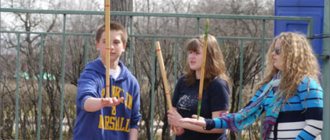Yard trip
Chile: “Run, run, guaraka!”
Did you often make up funny and non-existent words as a child? So Chilean children, who usually speak Spanish, were guilty of this. This is where the meaningless word “guaraca” came from, which is now associated with a fun yard game.
What are its rules? The company sits in a circle, having previously chosen a leader - a guaraca, who must discreetly place a scarf on the shoulder of one of the players. If the child senses it, then he chases the guarac. If he managed to catch up with him, then he is eliminated.
Greece: "Agalmata" ("Statue")
The hallmark of Greece is marble statues of ancient times. It is quite natural that these “characters” were included in a children's game. One of the participants is placed in the center with his eyes closed, he must count to 10 - when finished, everyone else assumes the poses of popular statues. They are allowed to use additional accessories such as swords and homemade spears. The presenter tries to make people laugh or move the “statues”: the one who loses his balance is eliminated from the game.
Pakistan: "Up and Down" ("Unch Nich")
Pakistan's cities are incredibly bustling, full of color and lots of people. At the first opportunity to get out of the close crowd, they organize an active game. Participants go to a playground with many obstacles, such as slides, swings, benches or rocks. If the leader shouts “Down!”, then the ground is declared dangerous territory and you cannot stay on it. Players climb to the top, and the one who does not have time is eliminated. When shouting “Up!” they do the opposite.
Ghana: Pilolo
In rural areas of Ghana in West Africa, children have a limited choice of toys, but they find many ways to have fun. The popular game "Pilolo" translated means "time to search." The leader hides the sticks within the designated area while others are not looking. He then shouts "Pilolo!" and the others go in search. The one who finds the most hidden objects wins.
UK: "Pass the Parcel"
“Pass the Parcel” is a popular English game that is enjoyed not only by children in their yards, but also by teenagers at parties. The idea is this: parents or organizers collect gifts and pack them in several layers. Then the participants sit in a circle and pass the boxes to each other while the music is playing, and when the song stops, they remove one layer. This continues until the last layer is removed.
Sumatra: "Ants, Men, Elephants"
On a small island in Indonesia, there is an elephant who has become a “participant” in a children’s game, very similar to the European “Rock, Paper, Scissors.” Children use it to determine the first player or just for fun. An ant is indicated with the little finger, a person with the index finger, and an elephant with the thumb. A man hits an ant because he might step on it. The ant defeats the elephant because it can crawl onto it. The elephant, in turn, can step on a person.
Australia: "Kangaroo Skippiro"
Australia is a mysterious and diverse continent filled with fascinating and frightening nature. The kangaroo became her calling card. The essence of the game “Skippiro” is that the participants sit in a circle: one of them, with his eyes closed, plays the role of a kangaroo, and the rest are hunters. The children begin to sing a humorous song. The presenter quietly calls the name of any child - he must touch the “kangaroo” and say: “Guess who caught you?” If the latter correctly pointed to the “hunter”, the players change places.
Israel: "Go-Go-Im"
In the middle of summer, apricot season begins in Israel, and children begin to play with the pits. Holes of different sizes are cut out in the boxes, into which the participants must hit with these same bones. The winner is selected based on the number of points scored.
Read on topic: “Nostalgia to the touch: remembering our favorite sweets of the 2000s and 1990s”
Boyars
This game combined two ancient games: the song came from the game “Boyars” from rural and merchant youth parties, and the action came from the boyish “Forged Chains” (another name is “Shackles”). Both children and adults participate in the game with great pleasure, primarily because of the funny text (in the traditional “Boyars” it is less funny - Boyars! what have you come for? / Young people, what have you come for? - Princesses! Yes, we are looking for brides! / Young, yes, we are looking for brides! - Boyars! show the groom, / Young, show the groom. - Princesses! This is our groom! / Young, this is our groom. - Boyars! Show us the caftan, / Young, show the caftan. - Princesses! This is our caftan! / Young, this is our caftan. - Boyars! Show us the sash! / Young, show us the sash! - Princesses! This is our sash! / Young, this is our sash. - Boyars! show the boots, / Young, show the boots. - Princesses! this is our boot, / Young, this is our boot. - Boyars! cheer up! / Young, with the whole train! (E. A. Avdeeva. Notes and comments about Siberia: with an appendix of ancient Russian songs. M., 1837). The participants of the game are divided into two equal teams, which stand in two ranks opposite each other, the players join hands. The teams begin to sing a question-and-answer song (in chorus, one at a time) and alternately take a few steps towards their opponents, then the same number in the opposite direction. When answering a question, one team goes forward, and when answering, the second team does. The first team starts:
- Boyars, we have come to you! (They go forward.) Young people, we have come to you! (They go back.) - Boyars, why did they come? (They go forward.) Young people, why did you come? (They go back.) - Boyars, we need a bride! Young people, we need a bride! - Boyars, which one do you need? Young people, which one do you need? - Boyars, we need this one! (They point to one of the players of the other team, agree in advance which one; gender does not matter.) Young people, we need this one! - Boyars, she is our fool! Young people, she is our fool! - Boyars, we’ll give you some gingerbread! Young people, we’ll give you some gingerbread! - Boyars, her teeth hurt! Young people, her teeth hurt! - Boyars, we’ll take you to the doctor! Young people, we’ll take you to the doctor! - Boyars, she will kill the doctor! Young people, she will kill the doctor! - Boyars, and we whip her! Young, and we whip her! - Boyars, she is afraid of the whip! Young people, she's afraid of whips! - Boyars, don’t play the fool, give us the bride forever!
After these words, the selected player runs up and tries to break through the clasped hands of the opponents. If he succeeds, he can take one of the strangers into his team; if not, he himself joins another team (“gets married”). The team with only one player left lost.
Games in Sudan
Sudanese herrings have slightly different rules and are called “Lion and Antelopes”. The lion is the driver, and the antelopes are the other players. The antelopes must close their eyes at the beginning of the game, and the lion must hide from them under a bush or behind a tree. The antelopes scatter around the area, not knowing where the lion is, so he can attack them completely unexpectedly. The caught participants go over to the driver’s side and help him.
A very fun game, popular in Sudan, is called “Buffaloes in the Corral.” Its rules are very simple: All participants form a circle, 2 or 3 players stand in a circle. They are called buffalos. Their task is to break through the circle with their arms raised using their running power. Players standing in a circle must prevent the buffalos from escaping. Those who failed to hold back the buffaloes go to their place.
There are many more countries with their own interesting games. In many countries there are similar games that differ only in the presentation itself. For example, all over the world you can find a huge number of tags and blind man's buff. The popularity of games depends on both the climate and the spiritual values of a particular people. For example, games with oranges are very popular in African countries, as there are a huge number of them there. Games are often associated with folk traditions. Even if a person lives in another country, nothing stops him from trying to play a game that is so popular among foreigners. Such games not only lift your spirits, but also unite different peoples. It is necessary to introduce a child to the culture of the world, and it is best and most interesting to do this in a playful way.
"Olympics"
You can jump with a rubber band, or you can play “Olympics” with it. Two people hold the rubber band from different sides and tangle it, crossing their arms, stepping on their feet and saying: “O-lim-pi-a-da, eat three I-da, fi-nish, start!” The result is a design reminiscent of a laser alarm. The remaining participants must take turns climbing through the largest holes without touching the elastic bands. The one who touches replaces any of the players holding and tangling the rubber bands.
A kindergarten group on a walk. Primorsky Territory, 1979 © Boris Kavashkin / RIA Novosti
Finland Games
Finland has its own version of bouncers. To play, draw a circle with a diameter of 8 meters. There are players in the circle, and behind the circle is the driver with the ball. His task is to knock out the player. The player who was hit by the ball leaves the circle and begins to help the driver. The following players also join. The last one left in the circle wins. The next game is called “Who has the item?” The driver stands near the chair and counts to fifty, and all the players hide within the pre-agreed territory. One of the players has an object, for example, a ball. The driver must find the player and touch him, then he is eliminated from the game. The driver must touch the player. His main task is to find the player with the ball. The driver should not move far from the chair, because If the player who has the ball runs out and puts the object on the chair, then it is considered that the driver has lost. The game starts again. Players can move around and tell the player with the item where the driver is now.






